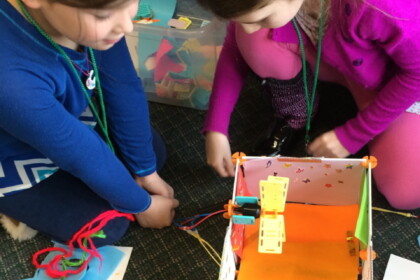
STEM In The Community

What’s Next for STEM Ecosystems

By Jan Morrison
Posted on August 11, 2022
Bipartisan Congressional approval of the CHIPS and Science Act, which was signed into law earlier this month, will drive an unprecedented $52 billion to expand and accelerate U.S. semiconductor manufacturing.
Embedded in this critically important effort to improve our nation’s economic competitiveness and national security is a recognition of the need for the next generation to be able to drive innovation, to think differently and to serve as the STEM workforce of tomorrow.
As a part of the legislation, the CHIPS and Science Act also calls for the National Science Foundation to develop Centers that will drive innovation in science, technology, engineering and math (STEM) throughout K-12 school districts.
This foresight was no accident.
Federal leaders have recognized the disastrous effects of a prolonged STEM talent shortage. They understand that to stay competitive and to grow, our economy needs students eager to pursue courses of study and training in STEM. These federal leaders also recognize that this is a heavy lift and not one that K-12 school districts can handle alone.
K-12 school districts need partnerships with business and industry, higher education, out-of-school-time providers, non-profits, philanthropy and others if they’re going to be able to engage students in meaningful pursuit of STEM.
This is where the STEM Learning Ecosystems Community of Practice and other organizations with similar mindsets and operating practices come into play. The STEM Learning Ecosystems, a global initiative of 100 communities, operating to provide STEM for all, is a stellar example of how to drive and scale innovation and equity in STEM.
In fact, STEM Ecosystems were specifically called out in the CHIPS and Science Act as one of the types of entities eligible for funding through the to-be-created NSF Centers.
The Ecosystems affiliated with the STEM Learning Ecosystems Community of Practice are already working to identify and share best practices in K-12 STEM innovation so that they are ready to support the NSF Centers with models that could be shared across the country.
In the coming weeks, we will begin sharing some of those models and are always eager for more partners and collaborators.
What’s Next for STEM Ecosystems and their partners related to the CHIPS and Science Act?
- In early August, TIES began collecting information about practices, programs and initiatives that Ecosystems are leading that could be scaled.
- In early August, we also began significant outreach to each of the 100 communities, taking a closer look at their needs and challenges as well as their opportunities and bright spots.
- In September, we will be holding a series of conversations to begin some matching and more program development – based on the initial responses to the RFI that was issued in August.
- We will be working with colleagues in Washington, D.C. to share the snapshots of Ecosystem work with those engaged in the process of setting up the NSF Centers.
- We will be watching closely for all news regarding the NSF Centers and grant opportunities.
- We will actively share all information with Ecosystems and develop collaborative funding requests that leverage Ecosystems’ strengths while addressing identified needs as well